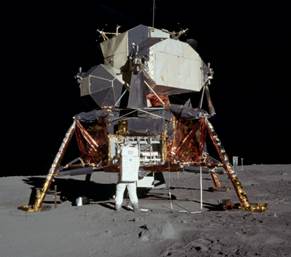Project Balto: Overview

Yesterday at 2:59am, we secretly landed the first men back on the Moon since 1972. Commander Alice Kramden and Lieutenant George Herbert successfully landed their lander at Maginus Crater, whilst their automated service module remained in orbit awaiting their return.

During their stay on the Moon, they did an excursion with their lunar rover and collected some rock samples, looking for traces of He3, which we hope to use to power future fusion reactors, as well as set up a science station near the lunar module.
Their mission completed, they boarded the lunar module for the return visit - which is where things started to go wrong.
The Commander was quoted as saying that, There was a crash and then a zoom, as we tried to take off from the Moon.
The lunar modules main engine refused to fire, and the crew could see they were venting from their craft. Later inspection from the outside of their craft showed that a key valve had blown in the propellant fuel line, and the module has vented its fuel for takeoff, stranding it on the Moon.

The good news is the oxygen tanks were not affected, and the crew has food and air to last for 30 days. Potentially 31 if everything goes favourably and exertion and trips outside are kept to an absolute minimum.

The bad news is we have no rescue or resupply rocket ready. Our expectations of such scenarios was that any incident would be outright fatal.
Project Balto: The Challenge

Project Balto is our planned resupply lifeline for the two astronauts stranded on the Moon. It is named after the famous Alaskan husky who ran supplies of medicine during a diphtheria epidemic.

We are used to running regular supply rockets up to the International Space Station every 3 months, but sadly we used our the other month, and its replacement is not constructed yet. That rocket uses a 2-stage rocket which gets into low Earth orbit. But to get to the Moon, it needs additional power, so we are adding an additional rocket stage to the base - similar to the one we used in our manned lunar rocket.
Stage 1 - Liftoff Stage

This is the stage that is used at take-off, and usually lifts a manned rocket into high Earth orbit. We have used these for 6 previous launches. It is reusable, but requires a huge service between uses - hence it has parachutes and beacons to help us retrieve and reuse it.
Key features,
- Recovery parachute
- Recovery beacon
- Propellant tanks
- Guidance fins
- Re-entry shields
- 64 rocket engines
- Separation changes
- Launch cameras
Stage 2 - Lunar Orbital Insertion

Once in orbit around Earth, this stage will take the vehicle out of Earth orbit and into an orbit around the Moon. This design has been used over 50 times to resupply the International Space Station, with low levels of failure. Like Stage 1, when used to supply the International Space Station, it is reusable.
Key features,
- Recovery parachute
- Recovery beacon
- Propellant tanks
- Steering rockets
- Re-entry shields
- 18 rocket engines
- Separation changes
- Black box monitor
Stage 3 - Cargo Package

Once in orbit around the Moon, this section will attempt to land nearby the lunar lander, where the astronauts can use their lunar rover to collect supplies.
Key features,
- Retro rockets
- Recovery beacon
- Propellant tanks
- Steering rockets
- Guidance computer
- Autopilot
- Pressurised cabin
- Radio
- Webcam
Stage suppliers
Each rocket stage is supplied by a different manufacturer,
- STAGE 1 - Zeus Inc
- STAGE 2 - Hera Ltd
- STAGE 3 - Hermes Industrial
And normally each stage is put on a freight train which takes 2 days to get to Cape Canaveral.

Initial Timetable
Our first attempt at making a timetable for this was,
| Action | Time |
|---|---|
| Stage assembly | 30 days |
| Stage testing | 20 days |
| Freight train to Canaveral | 2 days |
| Rocket integration | 15 days |
| Rocket testing | 10 days |
| Travel to the Moon | 2 days |
| Landing on the Moon / recovery | 1 day |
Revised Timetable

With the typical time to do this, the astronauts will all be dead by the time we are ready. So we are going to work around the clock, which gives us the following revised schedule,
| Action | Original | Revised |
|---|---|---|
| Stage assembly | 15 days | |
| Stage testing | 10 days | |
| Freight train to Canaveral | 2 days | 2 days |
| Rocket integration | 8 days | |
| Rocket testing | 5 days | |
| Travel to the Moon | 2 days | 2 days |
| Landing on the Moon / recovery | 1 day | 1 day |
This gets us closer, but the crew will be dead by the time it is ready.
Final Timetable
In order to meet this deadline, we cannot afford the dedicated test phases, although they increase the chances of a successful launch, as they do so, if we do delay, the crew will be dead for certain.
| Action | Original | Revised |
|---|---|---|
| Stage assembly | 15 days | |
| Stage testing | ||
| Freight train to Canaveral | 2 days | 2 days |
| Rocket integration | 8 days | |
| Rocket testing | ||
| Travel to the Moon | 2 days | 2 days |
| Landing on the Moon / recovery | 1 day | 1 day |
What can you do to reduce the chance of this happening?
